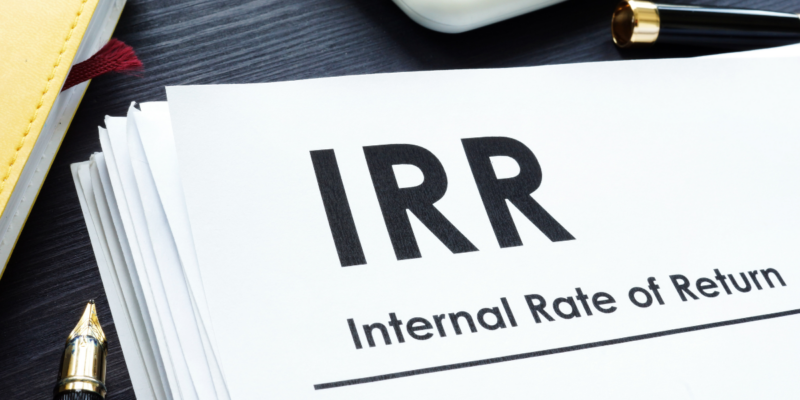
IRR means Internal Rate of Return, and it refers to the calculation of the rate of return that an investor can expect to earn from a real estate investment, considering the timing and size of cash flows generated by the property.
When it comes to making investment decisions in the real estate industry, understanding the concept of IRR. The full form of IRR is Internal Rate of Return which a crucial financial metric used to evaluate the profitability and attractiveness of an investment opportunity over time. It considers both the timing and magnitude of cash flows associated with a real estate project, giving investors a full measure of its potential returns.
Table of Contents
What is IRR?
At its core, IRR or Internal Rate of Interest represents the discount rate at which the present value of a project’s cash inflows equals the present value of its cash outflows. It is especially valuable in comparing different investment opportunities within the real estate sector. By calculating and comparing the IRRs of various projects, investors can determine which option offers the highest potential returns relative to the associated risks. It allows them to prioritise investments with the most favorable IRRs and align their investment strategies accordingly.
Key Components and Factors Influencing IRR
These include cash flows, time value of money, and initial investment. Let us explore each of these components in more detail:
-
Cash Flows:
These represent the outflows & inflows of money associated with an investment project over its life. Typically, these include initial investments (negative cash flows) and subsequent cash outflows generated by the project. Inflows can come from various sources, such as revenue from sales, cost savings, or salvage value. The magnitude and timing of these cash flows significantly impact the Internal Rate of Return calculations.
-
Time Value of Money:
This a fundamental concept in finance that recognises the idea that a dollar received today is worth more than a dollar received in the future. This concept arises because money can be invested or can earn return over time. To account for the time value of money, cash flows are discounted using a rate of return, typically the cost of capital or the required rate of return. The discounting process adjusts future cash flows to their present values, which allows for meaningful comparison and analysis.
-
Initial Investment:
This refers to the cash outflow required to start an investment project, which includes the cost of acquiring assets, capital expenditures, research and development expenses, and any other upfront costs. The initial investment is a critical factor in calculating the IRR because it directly affects the project’s cash outflows.
Benefits and Limitations of IRR in Real Estate Analysis
The Internal Rate of Return is a widely used financial metric in real estate analysis. It is a measure of the profitability of an investment and is commonly used to assess the viability of real estate projects. However, like any financial tool, IRR has its benefits and limitations.
Benefits of IRR in Real Estate Analysis
-
Evaluation of Profitability:
Internal Rate of Return helps determine the potential return on investment (ROI) by considering the time value of money. It considers both the timing and magnitude of cash flows, allowing investors to assess the profitability of a real estate project.
-
Comparison of Different Investments:
By calculating the rates of multiple projects, investors can evaluate and prioritise investments based on their expected returns.
-
Incorporation of Cash Flow Timing:
Unlike other metrics such as net present value (NPV) – which solely focuses on the total value of cash flows – IRR considers the timing of these cash flows. This aspect is particularly important in real estate investments, where cash flows vary significantly over a long period of time.
Limitations of IRR in Real Estate Analysis
-
Ambiguity in Reinvestment Assumptions:
The formula assumes that cash flows generated by a project are reinvested at the calculated IRR itself. However, it can be challenging to identify realistic reinvestment opportunities with the exact same rate of return. This assumption may not accurately reflect the actual reinvestment potential, and hence can affect the reliability of calculations.
-
Ignoring Cash Flow Magnitude:
The final result of IRR calculations does not reflect the absolute magnitude of cash flows, focusing solely on their timing. This limitation can lead to situations where projects with similar IRRs have vastly different cash flow amounts. Consequently, it may not provide a comprehensive picture of the profitability or feasibility of a real estate investment.
-
Sensitivity to Cash Flow Timing:
It assumes that all cash flows occur at precise dates and can be reinvested accordingly. However, in real estate, cash flows are often subject to uncertainties and delays. Fluctuations in the timing of cash flows can significantly impact the calculated rate, potentially leading to misleading conclusions.
How to Calculate IRR?
There are several methods to calculate Internal Rate of Return in real estate, including the following:
-
Manual Calculation:
This method involves using a trial-and-error approach to find the discount rate that makes the net present value (NPV) of the investment equal to zero. The discount rate that achieves this equilibrium is the rate.
-
Excel Spreadsheet:
If you want to figure out how to calculate IRR in excel for real estate, the software offers built-in functions to calculate it automatically. By inputting the positive and negative cash flows associated with the real estate investment over the holding period, the function in Excel can determine the rate of return.
-
Financial Calculators:
These streamline the process by allowing you to input the cash flows and obtain the rate directly.
-
Real Estate Investment Software:
Numerous real estate investment software programs are available that automate the calculation.
-
Online Calculators:
Various websites provide online calculators that allow you to input the cash flows and holding period, and then they calculate the rate for you.
The accuracy of calculations depends on the quality of the underlying data and assumptions made regarding the investment’s performance.
IRR Calculation Using a Financial Calculator
To calculate the internal rate of return using a financial calculator, follow these steps:
-
Input the Cash Flows:
Determine the cash flows associated with the investment or project.
-
Set the Calculator Settings:
Set the calculator to ‘Begin’ or ‘End’ mode, depending on whether the cash flows occur at the beginning or end of each period.
-
Calculate the IRR:
Once you have entered the cash flows and set the calculator settings, use the IRR function on your financial calculator.
-
Interpret the Result:
The calculator will display the calculated IRR as a percentage. This represents the discount rate at which the net present value (NPV) of the cash flows is zero.
Manual Calculation of IRR using NPV
Below is a step-by-step guide on how to calculate IRR in real estate manually:
-
Gather relevant data:
Collect all the necessary information about the real estate investment, including the initial investment amount, cash flows generated by the property, and the holding period.
-
Determine Cash Flows:
Calculate the net cash flows for each period. Net cash flow is the difference between the income generated by the property and the expenses incurred during that period.
-
Identify the Initial Investment:
Consider the initial investment amount, which includes the purchase price, closing costs, and any other expenses incurred at the beginning.
-
Set up the IRR Formula:
Assign a variable to the IRR and set up an equation that sums the present values of all the cash flows. Here is the equation or Formula –
NPV = CF₀/(1+IRR)⁰ + CF₁/(1+IRR)¹ + CF₂/(1+IRR)² + … + CFₙ/(1+IRR)ⁿ
Where:
NPV = Net Present Value (should equal zero for the IRR calculation)
CF₀ = Initial investment (negative value)
CF₁, CF₂, …, CFₙ = Net cash flows for each period (positive or negative values)
IRR = Internal Rate of Return (the variable to be solved) -
Solve for IRR:
Use numerical methods / trial & error to solve the equation for the value that makes the NPV equal to zero.
-
Interpret the Rate:
The resulting value represents the annualised rate of return on your real estate investment.
How to Calculate IRR for Commercial Real Estate Investments?
Calculating the internal rate of return for commercial real estate investments follows the same principles as any other investment. Below is a step-by-step guide on how to calculate IRR for commercial real estate investments:
-
Determine The Cash Flows:
Identify the expected cash flows associated with the commercial real estate investment.
-
Estimate the Initial Investment:
Determine the investment required upfront, for the commercial real estate project.
-
Organise the Cash Flows:
Arrange these in a chronological order, with the initial investment as a negative value occurring in the initial period, and subsequent cash flows as positive values occurring in the relevant periods.
-
Use a Financial Calculator or Software:
Utilise a financial calculator or specialised real estate investment software to calculate the IRR.
-
Input the Cash Flows:
Enter these into the calculator or software, ensuring the correct sign (positive or negative) is assigned to each cash flow. Consider the timing of the cash flows, as they may vary throughout the investment period.
-
Calculate the IRR:
Use the function in your calculator or software to determine this. The result will be presented as a percentage, representing the discount rate at which the net present value (NPV) of all cash flows is zero.
-
Evaluate the IRR:
Assess the calculated rate to determine the potential profitability of the commercial real estate investment. Compare it to your required rate of return or hurdle rate.
IRR vs ROI
IRR (Internal Rate of Return)
- Measures the profitability & potential return on an investment
- Represents the discount rate at which the net present value (NPV) of cash flows from an investment becomes zero
- Considers the time value of money by factoring in the timing & magnitude of cash inflows & outflows
- Helps in comparing different investment opportunities and selecting the most attractive one
- Provides a single percentage value to assess the overall return on an investment
- Reflects the compound annual growth rate of an investment over its holding period
ROI (Return on Investment):
- Measures the efficiency and profitability of an investment
- Represents the ratio of net profit (or gain) to the cost of the investment
- Provides a straightforward percentage value that shows the return relative to the initial investment
- Does not consider the time value of money or the specific timing of cash flows
- Useful for evaluating the performance of investments and determining their effectiveness
- Can be calculated for various time periods (monthly, quarterly, annually) to assess the investment’s performance over different periods.
Final Thoughts
In conclusion, understanding what is IRR in real estate investing is essential for investors looking to make informed decisions and maximise their returns. By utilising this metric, investors can assess the profitability, compare different investment opportunities, and gauge the feasibility of real estate projects. However, it is important to consider it in conjunction with other financial indicators & factors that may impact the investment’s overall success.
Also Read,
Real Estate Market in India: 2023 and Beyond
Can Foreigners Buy Property in India?
EOI (Expression of Interest) in Real Estate – A Comprehensive Guide
10 Best Cities for Real Estate Investment in India
FAQ’s
1. What is a good IRR rate for real estate?
For a real estate investment, a return of around 18-20% is relatively good. Any rate above 10% is considered to be decent.
2. How is IRR calculated in real estate?
There are several methods for this, including Manual Calculation, Excel Spreadsheet, Financial Calculators, Real Estate Investment Software and Online Calculators. Determine the cash outflows' total present value (PV), and the cash inflows’ total PV. The rate at which these two values are equal, would be the IRR. If it is higher than the minimum acceptable rate of return or the hurdle rate of a company, the project is favourable. If the IRR is lower than these rates, the company needs to decide if the project has any other benefits that can justify the gap.
3. What does a 20% IRR mean?
A 20% IRR means that an investment of ₹50,00,000 will give an interest of ₹10,00,000 annually. However, the final amount is calculated on a compound basis which means in the second year, interest will be added to the initial investment amount. A higher IRR is typically a better IRR. The IRR calculation is much more precise than its typical counterpart, return on investment (ROI) since it adds NPV, which takes cash in and cash out into consideration.
4. Is a 10% IRR good in real estate?
Generally, 10% IRR is a good return on a real estate investment. However, any rate lower than that would means reconsidering the investment options under consideration.
5. What does 30% IRR mean?
With a 30% IRR, you can expect an annual return of Rs. 9,00,000 if an investment of Rs. 30,00,000 has been made. Based on that, compound interest will be accumulated for a specific duration.
6. Is 19% a good IRR?
Yes, 19% IRR is good. If the rate is anywhere above 10%, the return on the property is considered profitable in the future.
7. What is the minimum IRR?
According to the internal rate of return (IRR) criterion, a project or investment should be undertaken if its IRR is higher than the hurdle rate or required rate of return, which is the minimum required rate of return. The IRR Rule aids businesses in determining whether to go ahead with a project or not. Regardless, investment can be made in the property if there are other benefits.









